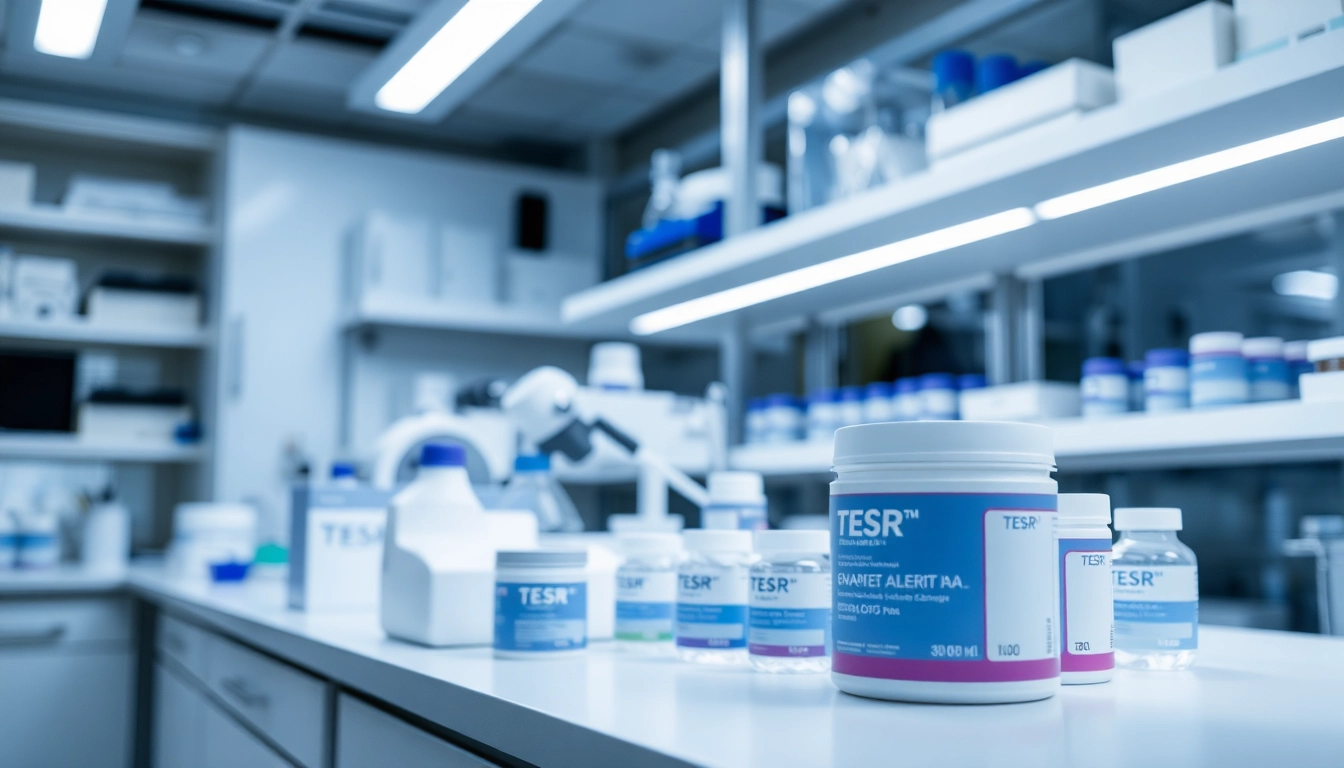Understanding TeSR™ Media Types
TeSR™ Family Overview
The TeSR™ family of culture media represents a significant leap in the maintenance and differentiation of human pluripotent stem cells (hPSCs). Developed by a team led by Dr. James Thomson, these media are specifically crafted to provide a feeder-free environment, which is invaluable in reducing variability in experiments. The TeSR™ media line includes formulations such as mTeSR™1, mTeSR™ Plus, TeSR™-AOF, and several others tailored to specific purposes, including reprogramming and differentiation. Designed extensively for both human embryonic stem cells (hESCs) and induced pluripotent stem cells (iPSCs), each specific formulation within the TeSR™ family is aimed at addressing particular challenges in stem cell research.
Feeder-Free Media Benefits
Feeder-free culture media, like those in the TeSR™ series, revolutionize the way researchers can handle hPSCs. Eliminating the need for feeder layers, which can introduce variability due to animal-derived products, these media streamline the culture process. This transition to feeder-free settings not only enhances all check but also promotes higher levels of cell consistency and reproducibility in research outcomes. Additionally, feeder-free media reduce the risk of contamination and simplify the process of scaling up for therapeutic applications.
Applications in hPSC Cultivation
TeSR™ media are designed for multiple applications, facilitating the generation and maintenance of hPSCs through their life cycle. They are utilized for:
- Routine maintenance of hPSCs
- Efficient reprogramming of somatic cells to iPSCs
- Directing cellular differentiation into specific lineages
- Cryopreservation of stem cell lines to ensure longevity and viability
This comprehensive suite of media supports researchers in maintaining optimal culture conditions, ensuring that the hPSCs retain their pluripotency and genomic integrity throughout their lifecycle.
How to Choose the Right TeSR™ Media
Evaluating Research Needs
Choosing the appropriate type of TeSR™ media requires a clear understanding of the specific research goals. For instance, if the aim is to reprogram adult somatic cells into iPSCs, formulations like TeSR™-E7™ or ReproTeSR™ are essential due to their optimized components for that specific task. Conversely, for standard maintenance, mTeSR™1 or mTeSR™ Plus should be selected based on the required forgoing recommendations of quick media changes and enhanced buffering capacities.
Comparative Analysis of TeSR™ Options
When selecting between the various TeSR™ media options, it’s essential to compare the formulations based on performance metrics such as:
- Cell viability and growth rate
- Consistency and predictability of differentiation
- Scalability for bioreactor systems
- Stability during prolonged culture periods
Each product line may have different concentrations of essential growth factors, such as FGF2, which directly influence cell health and division rates.
Utilizing the Interactive Product Finder
STEMCELL Technologies offers an interactive product finder tool that helps researchers identify the most appropriate TeSR™ media for their specific experimental requirements. This tool takes into account various factors such as the cell type, intended application, and any particular characteristics that may be necessary for their work, guiding users toward an optimal choice that meets their needs.
Technical Specifications and Formulations
Key Components of TeSR™ Media
Each TeSR™ media variant features a unique composition of ingredients that supports the growth and maintenance of hPSCs. Key components often include:
- Basal culture media (like DMEM/F-12)
- Supplements (such as L-glutamine and sodium bicarbonate)
- Growth factors (including FGF2 and TGF-β)
These components ensure that cells maintain their pluripotency and have the capacity to proliferate under optimal conditions.
Manufacturing Process Overview
The manufacturing of TeSR™ media is conducted employing stringent protocols to guarantee high batch-to-batch consistency. This standardized approach is fundamental in stem cell biology, where even minor variations in media formulation can lead to significant differences in stem cell behavior and functionality. Each batch is subjected to rigorous quality control checks to comply with the demanding standards of research applications.
cGMP Compliance and Quality Assurance
TeSR™ products like mTeSR™ Plus and TeSR™-AOF are manufactured in accordance with current Good Manufacturing Practices (cGMP). This compliance provides peace of mind regarding product safety and efficacy, particularly important for any translational research aimed at clinical applications. The adherence to these standards enhances the reliability and suitability of TeSR™ media for future clinical trials.
Best Practices for hPSC Maintenance
Optimal Culture Conditions
To maintain hPSCs effectively, researchers must ensure optimal culture conditions. These include:
- Maintaining a sterile environment to prevent contamination
- Choosing appropriate incubator settings (typically, 37°C with 5% CO2)
- Monitoring and adjusting pH and osmolarity of the media
By adhering to these guidelines, researchers can maximize cell viability and function, securing a healthy culture system for downstream applications.
Media Change Strategies
Strategies regarding media changes are crucial for sustaining healthy stem cell cultures. Depending on the specific TeSR™ formulation chosen, researchers may adopt the following strategies:
- Regular changes every 2-3 days for maintenance media like mTeSR™1
- Utilizing more stable options such as mTeSR™ Plus, which can extend change intervals without substantially compromising cell health
Implementing the correct media change strategy contributes to optimal cell health and reduces the frequency of experimental variances.
Assessing Cell Health and Viability
Regular assessments of cell health and viability should form an integral part of the cell maintenance protocol. Techniques such as:
- Trypan blue exclusion assay
- Flow cytometry for pluripotency markers
- Microscopic evaluations for morphological abnormalities
should be employed routinely. These assessments provide insights into cell health, allowing researchers to make informed decisions regarding sub-culture and differentiation protocols.
Future Directions in Pluripotent Stem Cell Research
Innovative Uses of TeSR™ Media
As research in stem cell biology continues to evolve, the versatility of TeSR™ media opens up new avenues. Innovative uses include:
- Implementing 3D culture techniques with mTeSR™3D to enhance differentiation outcomes
- Exploring potential therapeutic applications through engineered differentiation protocols
- Developing novel gene editing strategies in conjunction with optimized media formulations
This unwavering adaptability of the TeSR™ range positions it as a critical resource in ongoing and future research endeavors.
Expert Interviews and Insights
Consultations with leading experts in the field have unveiled crucial insights into using TeSR™ media effectively:
- Dr. Joseph C. Wu highlights the potential of TeSR™ media in differentiating hematopoietic cells, stressing the importance of formulation choice.
- Dr. Andrew Elefanty emphasizes the need for precise media conditions in deriving definitive endodermal lineages.
- Dr. Robert Zweigerdt shares observations on scalability in bioreactor structures when using TeSR™ media.
These expert opinions provide foundational knowledge for optimizing media use in both basic and applied research settings.
Emerging Trends in Cell Reprogramming
The realm of cell reprogramming is witnessing rapid advancements. Variants of the TeSR™ media are paving the way for novel approaches, including:
- Utilizing targeted factors in a controlled manner to achieve reproducibility in iPSC formation
- Refining protocols for enhanced efficiency and fidelity in cell conversions
- Integrating smart technology to monitor culture parameters in real-time
Such trends underscore the pivotal role that highly optimized media play in advancing stem cell technologies, driving research toward increasingly innovative outcomes.



